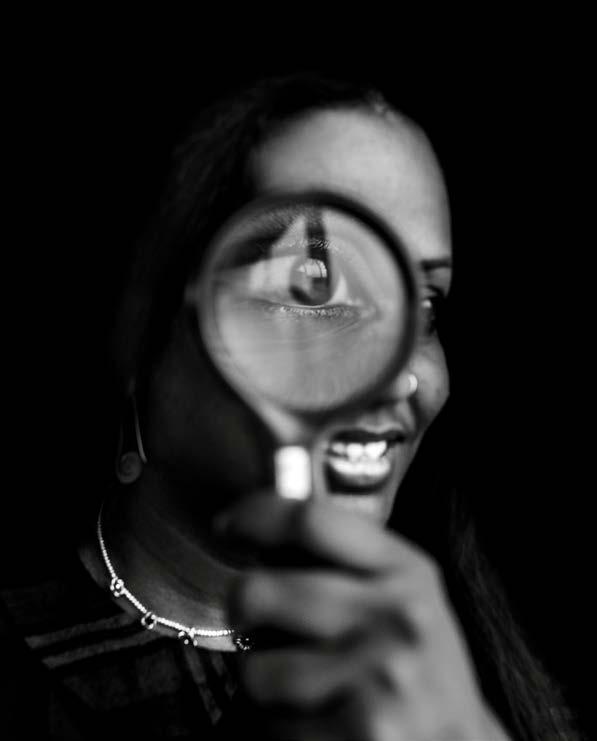
MITHU SEN u myth N
u myth N
UNMYTHU: UNKIND(S) ALTERNATIVES
Installation detail
9th Asia Pacific Triennial Australia, 2018

PUBLISHED BY SUPPORTED BY


UNMYTHU: UNKIND(S) ALTERNATIVES
Installation detail
9th Asia Pacific Triennial Australia, 2018

PUBLISHED BY SUPPORTED BY
Works and Worlds of Mithu Sen
EDITED BY IRINA ARISTARKHOVA with essays by Sushmita Chatterjee
Karin Zitzewitz
Irina Aristarkhova
Nancy Adajania
Max Delany
Fictional Interview by Mithu Sen

100 (UN)SILENT WAYS Lecture-performance India Art Fair India, 2019
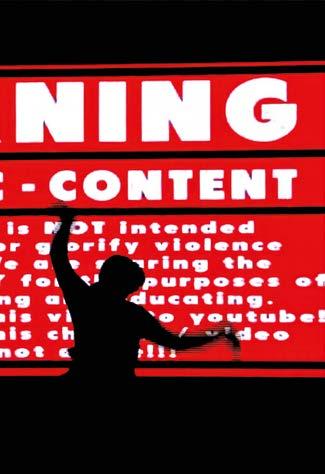

Un is libertarian freedom in a state of flux. Un is a linguistic tool in my vocabulary, a prefix, an extratextual being and a narrative trope to confront codified structures and hierarchies. Un deconstructs fixed societal systems into a perpetual unsettlement via methodologies of play, vulnerability and intuition with a flair for wit and irony.
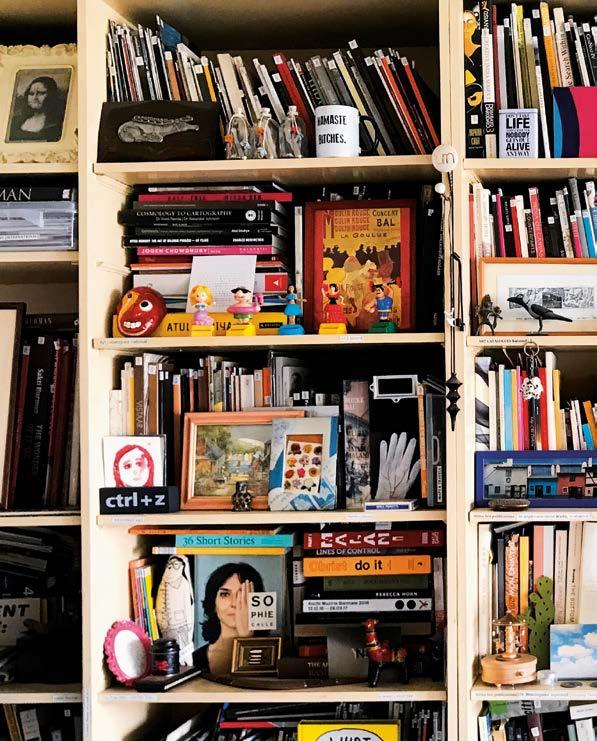

preface
IRINA ARISTARKHOVA
sen's unworld 16 essays
MITHU SEN MITHU SEN
IRINA ARISTARKHOVA glitch tongue: savaging the civilized NANCY ADAJANIA mOTHERTONGUE MAX DELANY the five pillars 24
unmithu’s politics: lingual anarchy and playful undoings SUSHMITA CHATTERJEE the precise calibration of desire KARIN ZITZEWITZ the radical hospitality of mithu sen: no matter if it takes me a lifetime
340 artist bibliography fictional interview list of artworks artist biography index thematic descriptions
359 contributors’ biographies artist acknowledgements
128 MITHU SEN RESPONDS TO REAL AND IMAGINARY FIGURES ABOUT THE KEY ASPECTS OF HER OEUVRE
299
304
312
348 358


IRINA ARISTARKHOVA
This artist monograph, Unmyth: Works and Worlds of Mithu Sen, presents the first comprehensive study of the artworks of Mithu Sen. Sen’s work spans over two decades of making and hundreds of exhibitions, projects, performances and word art. This book enables you, the reader, to encounter Sen’s unique vision through several pathways. In addition to offering a wide-ranging documentation of the individual works and exhibitions, the volume contains analytical texts written by scholars and curators who have followed Sen’s work for many years and who position Sen within a broad range of conceptual and art historical contexts globally and in India and, where relevant, include biographical information. Sen has a decades-long history of experimentation with materials and concepts, which are covered here as well. In all these aspects, the book follows a wellestablished tradition of looking at the entire oeuvre of the maker: Sen’s aesthetic trajectory, whether it be poetry, other writing, performance or representation. To complement these, there is an original “Fictional Interview,” written by Sen in a poetic performative form. In this “Fictional Interview,” some of the interviewers are anonymous characters while others are famous historical, mythological or personal figures important to Sen. Throughout the decades, one imagines Sen, the artist, has been asked all kinds of questions about her practice. Some of the questions appearing in “Fictional Interview” could be these very questions. Others could be imaginary ones that Sen wishes she would have been asked, and this form offers her a chance to respond to them. Hence, the “fictional” part of “Fictional Interview” is understood broadly as being a play on the art’s complicated relationship with reality and authorship.
This monograph is organized thematically around key concepts in Sen’s work. Among them are mything, unmything and post-mything; radical hospitality; untaboo sexuality; lingual anarchy; critiquing institutions and countering capitalism; unmonolith identity; byproducts and contracts. Throughout the book, these and other concepts are engaged with systematically by the artist and the other authors through conceptual captions, dispersed citations and essays. Any one work can speak to several concepts that represent the artist’s vision and intentions. And each work also engages with its audience on its own, through affective reciprocal communication and without prescribing a particular reading. The reader could imagine oneself inside an exhibition, spanning over two decades, like in a virtual world, partaking from Sen’s incredibly impactful work in all its multiplicity and complexity.
This book is called Unmyth. So, what are these concepts of mything, unmything and post-mything that form shareable existential experiences inside Sen’s cosmology? Life is a disparate and disorganized journey, and myths have suggested and imposed forms and meanings on its chaos. Myths soothe us into a sense of community, with its subsequent pleasures and tyrannies, where community itself breaks down the moment it declares its arrival and considers itself a tradition. As the process towards the entropy of each life sets in from the moment of birth, one starts noticing the stiches in the fabric of inherited myths. Sen reveals these stiches, whether we want to recognize them as such or not. The artist creates as a primordial being, a mother of all becoming, working with the entire cultural code over time to engender her own shawl of life and offer it to us as a new, albeit non-fossilized and alive, code. Some elements are familiar while others are alien. As with any myth, they are lulling and disturbing at the same time. Sen is actively creating new worlds for us, both to escape to and from.
In April 2023, I had the pleasure of attending Sen’s survey exhibition mOTHERTONGUE. Max Delany had curated it at the Australian Centre for Contemporary Art (ACCA) in Melbourne and had edited a catalogue that accompanied the exhibition, in partnership with Chemould Prescott Road and the Kiran Nadar Museum of Art (KNMA). The show touched upon the major themes in Sen’s artistic practice and featured several new works created in 2022 and 2023 for this exhibition. I am delighted that this book contains two texts from the ACCA catalogue by Max Delany and Nancy Adajania that address Sen’s most recent work (as of 2023).
This artist monograph has been a multi-year collaborative effort made possible by the following individuals and organizations, and our editorial and production team is deeply indebted to them: first and foremost, Shireen Gandhy and Chemould Prescott Road, the gallery that has represented Sen’s work since 2006, for supporting the book from the very beginning; Rosalyn D’Mello for her editorial assistance during the initial stages and Anusha Yadav, whose brilliant book design is an integration of her own imagination and an in-depth understanding of Sen’s art practice. Additionally, Yadav has been a pleasure to work with throughout the last few difficult, for all of us, pandemic years. I thank the contributors, all amazing writers, scholars and curators whom I personally admire and engage with in my own thinking and writing: Sushmita Chatterjee and Karin Zitzewitz for writing new essays for this book and Nancy Adajania and Max Delany for permission to reprint their texts from the ACCA catalogue mOTHERTONGUE. The team at Mapin Publishing has been a pleasure to work with, and I am grateful for their expertise and professionalism. Finally, this book is about Mithu Sen’s genius. The artist who has had a profound impact on the global field of contemporary art now has a monograph which is meant as a resource for current and future scholars, students and wider audiences.
POLITICS OF GENDER, SEXUALITY, LOCATION, REPRESSION, VIOLENCE BODY
LINGUAL ANARCHY
RADICAL HOSPITALITY UNMYTH
MEDIUM & MATERIALITY
CRITIQUING INSTITUTIONS & COUNTERING CAPITALISM
BYPRODUCTS & CONTRACT

DISAPPEARANCE & INTANGIBILITY
UNCATHARSIS (100)SECOND-HAND DROPS
Video performance still Climate Group’s Climate Week USA, 2020
COGNITIVE IGNORANCE
COUNTER-MYTH AS A PROPOSITION
The spiral triad of myth—unmyth—post-myth dominates my methodology, performance and politics to demonstrate the commitment of radical hospitality in my practice when reflecting on the idea of myth. Myth represents constructed societal norms and conditions; unmything employs subversions in perpetual unsettlement and deconstruction while postmyth is a third space, a radical outcome of the myth–unmyth binary that goes beyond deconstruction, opposition and negation.


UNTIL YOU UNHOME
Detail
Art Basel Switzerland, 2021
Myth is a layering of regulations that usually go unchecked. When a phenomenon is treated as a myth, be it the persona of an artist or the art market, it is addressed as megalithic. I am committed to ideas of perpetual unsettlement and constant becoming, largely shaped by the accumulation of specific ideas over time. Gender and sexuality subversions as well as the embodiment of language fluctuate in prominence. However, all these layers continue to be challenged by my exploration of the monolith of myth.
Positing myth in binary opposition to unmyth restricts the nuanced understanding of mythmaking. I navigate a spiral channel from myth to unmyth to post-myth, intertwining conceptual underpinnings.
Myth serves as a trope that unveils the constructed nature of reality, contrasting with the perceived objectivity we assign to it. Unmything exposes the constructed character of norms related to gender, sexuality, caste, class, race and the nation-state.
MythING MyTH
Myth, unmyth and post-myth are interconnected ideas that form a triad representing my exploration of the idea of myth. While myth and unmyth are linked processes, post-myth serves as both an interrupter and an outcome of this relationship. The concept of post-myth goes beyond deconstruction, opposition and negation, invoking a third space. In this sense, each of my projects proposes a movement towards the post-myth, aiming to transcend conventional notions of myth and its subversion.
PosT-MyTH



Five narrative aspects developed within my practice over the years. They are connectors; they join the dots and reveal constructed realities produced in our minds and actualized in our interactions. They are interdependent, formless and deeply implicated with one another.
These five pillars or conceptual connectors are:
1 | Radical hospitality 2| Counter capitalism
Lingual anarchy
Untaboo sexuality
Unmonolith identity
Radical hospitality discomforts the conventions of human interactions constructed through cultural and social norms. Through the deconstruction of institutional spaces and the reevaluation of the imposed norms of hospitality, it seeks to capture the disorientation inherent in human nature and the predetermined, preconceived nature of human psychogeography in which the future is pre-organized, predicted, pre-assumed and pre-coded. Deconstructing the role-play between the host(ess) and the guest, I explore the recesses that inhabit the underside of social norms and imposed etiquettes that constantly (re)define otherness. I both question and subvert the institutionalized cultural diktat and playfully (un)draw the line of tolerance that is endemic to human interactions. This questioning leads me to a zone of propositions. I hope to create and visualize them as possibilities, both absurd and plausible.
CoUnTER CaPITALISm
My art practice and the resulting byproducts actively counter capitalism by challenging the conventional conduits of consumerism of our contemporary globalized existence. Artworks involving much intellectual, emotional and affective labour often get marginalized or overlooked in favour of marketable material products. By shifting the focus onto the byproducts of my work and decentering the material creations, I aim to redefine the role of affective labour and highlight its undervalued significance.
LiNGUAL ANarCHY
Lingual anarchy is an artistic strategy by which I suspend, subvert and resist the hegemony of the dominating language(s) exerted through the thickets of hierarchies, codifications, histories of colonialism, capitalism, conservatism and neoliberalism. By employing linguistic exploration through absence, erasure, gibberish, glitch, noise, silence and the nonsensicality of radical glossolalia, I examine the limits and possibilities of communication in the contemporary context. Lingual anarchy proposes a nonproductive mode of communication not codified by the hierarchical baggage of languages, particularly the lingua franca.
UnTABOO SEXUALITY
UnMONOLITH IDENTITY
My works explore the complexities of the body, exposing tabooed facets and pushing their boundaries and confronting viewers with grotesque aesthetics. By fragmenting and unspooling bodies, I present how parts signify the whole. The absent presence of the body is a recurring theme. In line with my unpractice, I move from body to no body, embracing the concept of unbody.
Challenging the socially imposed myth of identity and expanding on cultural anxieties around identity, I delve into the complexities of the artist as a fusion of personhood, culture, gender, market and intellectual discourse. Embracing emotionality and strategies of self-erasure and resistance, I navigate the intersections and contradictions of my multiple selves. This intentional complexity defies simplification. Women artists from the Global South often confront flattened identities and clichéd expectations, commodified for a global audience. In response, I shift the fetishizing gaze towards the Global North and the institutions perpetuating these stereotypes.
Through the politics of mythmaking, I seek to present my art practice tangibly as byproducts. This process focuses on the conceptual—the mind, the emotions and the senses that produce the art—and the byproducts are its remnants.
I approach the element of play with a serious intention, or as I call it, playbour or playing with labour, utilizing the art of seduction to captivate the audience and transform it into a subversive strategy.
Contractual self-declaration
Contract making, a politics of agency, resonates with my work’s themes of responsibility, sincerity and transparency. It embodies solidarity and linguistic ambiguity, demanding to be seen, read and understood. The contract fosters interactivity and mutual understanding, validating itself within the artwork. It amplifies collaboration, starting with an emotional and psychic connection and extending to a broader social community. This prompts viewers to contemplate contradictions and deeper meanings, engaging with the elements of absurdity, temptation and utopia for deeper reflection.



IN HOUSE ADOPTION Installation view Galerie Steph and Nature
Singapore, 2012
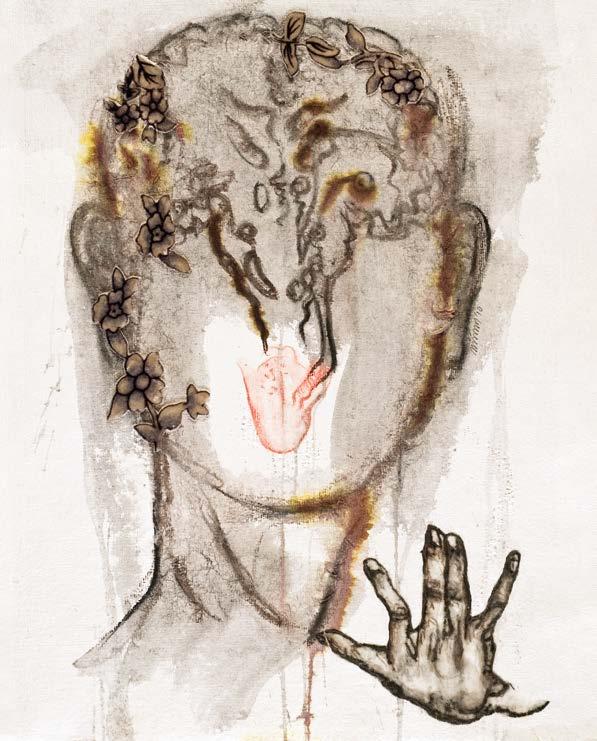

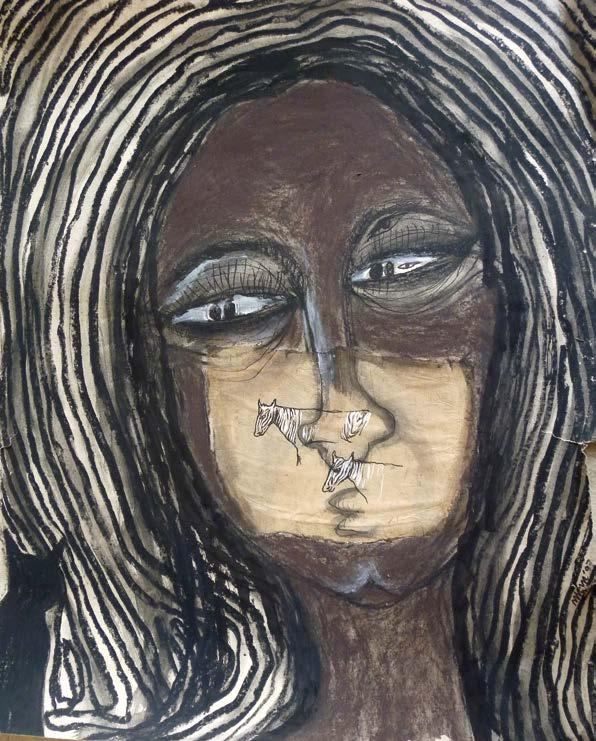
JOURNEY THROUGH ZEBRA CROSSING Drawing AIFACS India, 1998
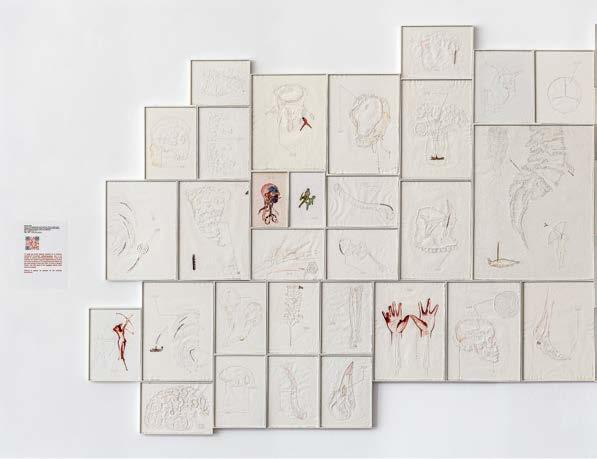


how to write about an artist whose modus operandi is to defy hierarchy, subvert definitions, flee capture and jostle societal and cultural establishments? In what language should I attempt to write about lingual anarchy, playful undoings and the exuberant buoyancy in using life as a conduit for art? While conundrums persist in being able to write about Mithu Sen, it is inspiring and stirring to make the attempt. A certain capacious broadening of horizons permeates Sen’s works that embraces the audience in an infectious revelry. Noting the complexities and excitement in the task of writing about Sen’s art practice, I endeavour to address the persisting thread of lingual anarchy in Sen’s art—heeding all the while its entanglements with themes commenting on capitalism, hospitality, gender and sexual subversions.
Sen’s artworks are always complex, exploring multiple themes that compel us to ask: Is it possible to distance questions of language from gender or capitalism? What interests would we be serving in making these differentiations? A persistent questioning marks my attempts to read Sen’s art as we unravel the confluences and trajectories stemming outwards, very much like the paintings in her artistic repertoire that display trees with roots spanning outside the picture frames. Working with the impossibility of singling out one issue, I read Sen’s politics of lingual anarchy as a motif that weaves its way through multiple works, amplifying the artist’s intentions to provide a counter-frame for social and political issues. An exuberant play with societal expectations and protocol undergirds the artist’s linguistic disruptions. One can confidently state that a play with language—its rules, grammar and meanings—is a central thread weaving through Sen’s artworks. As she explains, 1
“Unlanguage is part of a practice I call lingual anarchy, which aims to expose and unsettle how language (often the colonial remnant of English) functions as a hierarchical institution.”
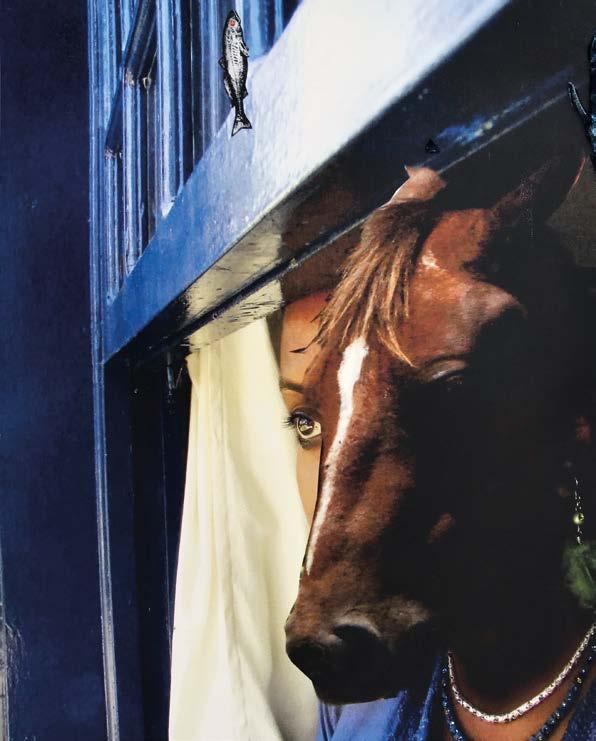
SUPPORTED BY
3RD FLOOR, QUEENS MANSION
G TALWATKAR MARG, FORT
MUMBAI 400001 INDIA
+91 22 22000-211 / 212 / 213 • ADMIN@GALLERYCHEMOULD.COM
WWW.GALLERYCHEMOULD.COM
BOOK DESIGN
Anusha Yadav, India
FRONT AND BACK COVER
Mithu Sen Portrait 1 & 2 | © ORIGINAL PHOTOGRAPHS Lukasz Augusciak, Poland
Front and Back Cover Images have been digitally altered for design purposes.
© Artworks: Mithu Sen
© Photographs of artworks courtesy galleries or institutions as listed, except listed below: 18th Street Arts Center, Los Angeles: p. 230.
Australian Centre for Contemporary Art, Melbourne: pp. 190, 238, 248, 256, 273.
Anay Mann, Khoj: p. 359.
Anil Rane: p. 126.
Diana Lelonek, Galeria Miejska Arsenał, Poznań: p. 269.
Solomon R. Guggenheim Museum, New York: p. 62.
heist Gallery, London: p. 75.
Khalid Ibrahim from Eli and Edythe Broad Art Museum, Michigan: p. 46.
Kunstmuseum Wolfsburg: p. 200.
The National Museum of Modern Art, Tokyo: p. 202.
Peabody Essex Museum, Salem: p. 28.
Printed with permission from Julia Ritterskam: p. 172.
Queensland Art Gallery and Gallery of Modern Art: p. 69.
Queens Museum, New York: p. 77.
Samit Das: pp. 155, 242.
TATE Modern, London / Pallavi Paul: p. 57.
PUBLISHED BY
FIRST PUBLISHED IN INDIA IN 2024 BY MAPIN PUBLISHING PVT. LTD 706 KAIVANNA, PANCHVATI, ELLISBRIDGE AHMEDABAD 380006 INDIA
T: +91 79 40 228 228 • E: MAPIN@MAPINPUB.COM WWW.MAPINPUB.COM
© TEXT: Sushmita Chatterjee, Karin Zitzewitz, Irina Aristarkhova, Nancy Adajania, Max Delany and Mithu Sen
ALL RIGHTS RESERVED UNDER INTERNATIONAL COPYRIGHT CONVENTIONS. NO PART OF THIS BOOK MAY BE REPRODUCED OR TRANSMITTED IN ANY FORM OR BY ANY MEANS, ELECTRONIC OR MECHANICAL, INCLUDING PHOTOCOPY, RECORDING OR ANY OTHER INFORMATION STORAGE AND RETRIEVAL SYSTEM, WITHOUT PRIOR PERMISSION IN WRITING FROM THE PUBLISHER.
THE MORAL RIGHTS OF SUSHMITA CHATTERJEE, KARIN ZITZEWITZ, IRINA ARISTARKHOVA, NANCY ADAJANIA, MAX DELANY AND MITHU SEN AS AUTHORS OF THIS WORK ARE ASSERTED.
ISBN 978-93-94501-87-4
COPYEDITING Roshan Kumar Mogali / Mapin Editorial
PRINTED AND BOUND AT Silverpoint, India
MODERN & CONTEMPORARY ART
Works and Worlds of Mithu Sen
Ed.by Irina Aristarkhova
364 pages, 146 photographs
8.25 x 10.25” (210 x 260 mm), hc-plc
ISBN: 978-93-94501-87-4
₹3500 | $70 | £49
Nov. 2024 • World rights
